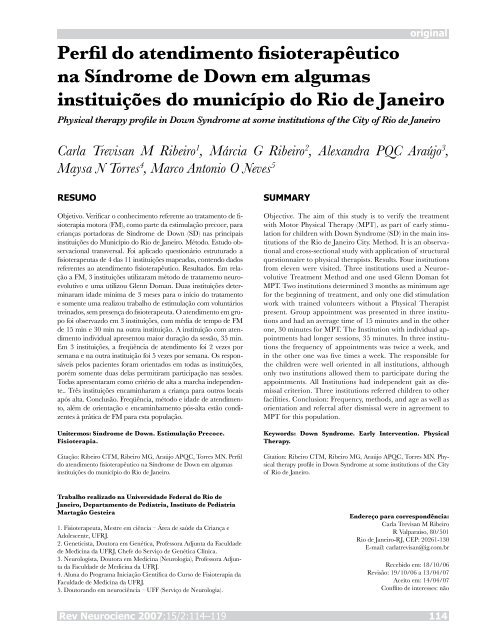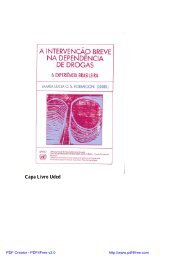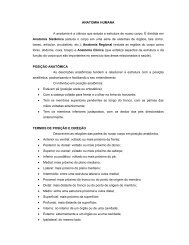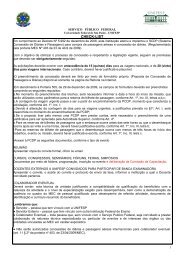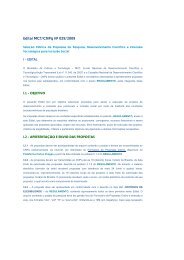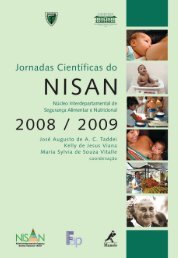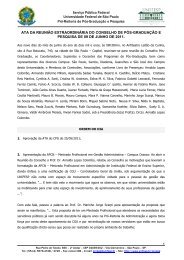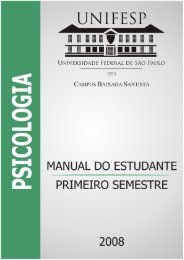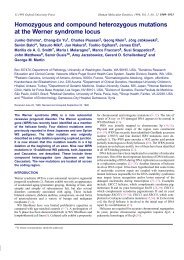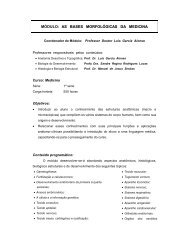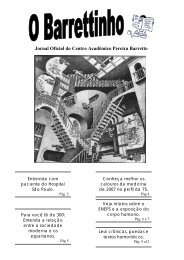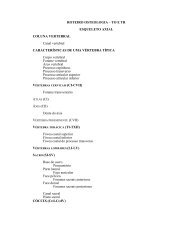Revista Volume 15 Número 2 2007 - Unifesp
Revista Volume 15 Número 2 2007 - Unifesp
Revista Volume 15 Número 2 2007 - Unifesp
You also want an ePaper? Increase the reach of your titles
YUMPU automatically turns print PDFs into web optimized ePapers that Google loves.
original<br />
Perfil do atendimento fisioterapêutico<br />
na Síndrome de Down em algumas<br />
instituições do município do Rio de Janeiro<br />
Physical therapy profile in Down Syndrome at some institutions of the City of Rio de Janeiro<br />
Carla Trevisan M Ribeiro 1 , Márcia G Ribeiro 2 , Alexandra PQC Araújo 3 ,<br />
Maysa N Torres 4 , Marco Antonio O Neves 5<br />
RESUMO<br />
Objetivo. Verificar o conhecimento referente ao tratamento de fisioterapia<br />
motora (FM), como parte da estimulação precoce, para<br />
crianças portadoras de Síndrome de Down (SD) nas principais<br />
instituições do Município do Rio de Janeiro. Método. Estudo observacional<br />
transversal. Foi aplicado questionário estruturado a<br />
fisioterapeutas de 4 das 11 instituições mapeadas, contendo dados<br />
referentes ao atendimento fisioterapêutico. Resultados. Em relação<br />
a FM, 3 instituições utilizaram método de tratamento neuroevolutivo<br />
e uma utilizou Glenn Doman. Duas instituições determinaram<br />
idade mínima de 3 meses para o início do tratamento<br />
e somente uma realizou trabalho de estimulação com voluntários<br />
treinados, sem presença do fisioterapeuta. O atendimento em grupo<br />
foi observazdo em 3 instituições, com média de tempo de FM<br />
de <strong>15</strong> min e 30 min na outra instituição. A instituição com atendimento<br />
individual apresentou maior duração da sessão, 35 min.<br />
Em 3 instituições, a freqüência de atendimento foi 2 vezes por<br />
semana e na outra instituição foi 5 vezes por semana. Os responsáveis<br />
pelos pacientes foram orientados em todas as instituições,<br />
porém somente duas delas permitiram participação nas sessões.<br />
Todas apresentaram como critério de alta a marcha independente..<br />
Três instituições encaminharam a criança para outros locais<br />
após alta. Conclusão. Freqüência, método e idade de atendimento,<br />
além de orientação e encaminhamento pós-alta estão condizentes<br />
à prática de FM para esta população.<br />
Unitermos: Síndrome de Down. Estimulação Precoce.<br />
Fisioterapia.<br />
Citação: Ribeiro CTM, Ribeiro MG, Araújo APQC, Torres MN. Perfil<br />
do atendimento fisioterapêutico na Síndrome de Down em algumas<br />
instituições do município do Rio de Janeiro.<br />
SUMMARY<br />
Objective. The aim of this study is to verify the treatment<br />
with Motor Physical Therapy (MPT), as part of early stimulation<br />
for children with Down Syndrome (SD) in the main institutions<br />
of the Rio de Janeiro City. Method. It is an observational<br />
and cross-sectional study with application of structural<br />
questionnaire to physical therapists. Results. Four institutions<br />
from eleven were visited. Three institutions used a Neuroevolutive<br />
Treatment Method and one used Glenn Doman fot<br />
MPT. Two institutions determined 3 months as minimum age<br />
for the beginning of treatment, and only one did stimulation<br />
work with trained volunteers without a Physical Therapist<br />
present. Group appointment was presented in three institutions<br />
and had an average time of <strong>15</strong> minutes and in the other<br />
one, 30 minutes for MPT. The Institution with individual appointments<br />
had longer sessions, 35 minutes. In three institutions<br />
the frequency of appointments was twice a week, and<br />
in the other one was five times a week. The responsible for<br />
the children were well oriented in all institutions, although<br />
only two institutions allowed them to participate during the<br />
appointments. All Institutions had independent gait as dismissal<br />
criterion. Three institutions referred children to other<br />
facilities. Conclusion: Frequency, methods, and age as well as<br />
orientation and referral after dismissal were in agreement to<br />
MPT for this population.<br />
Keywords: Down Syndrome. Early Intervention. Physical<br />
Therapy.<br />
Citation: Ribeiro CTM, Ribeiro MG, Araújo APQC, Torres MN. Physical<br />
therapy profile in Down Syndrome at some institutions of the City<br />
of Rio de Janeiro.<br />
Trabalho realizado na Universidade Federal do Rio de<br />
Janeiro, Departamento de Pediatria, Instituto de Pediatria<br />
Martagão Gesteira<br />
1. Fisioterapeuta, Mestre em ciência – Área de saúde da Criança e<br />
Adolescente, UFRJ.<br />
2. Geneticista, Doutora em Genética, Professora Adjunta da Faculdade<br />
de Medicina da UFRJ, Chefe do Serviço de Genética Clínica.<br />
3. Neurologista, Doutora em Medicina (Neurologia), Professora Adjunta<br />
da Faculdade de Medicina da UFRJ.<br />
4. Aluna do Programa Iniciação Científica do Curso de Fisioterapia da<br />
Faculdade de Medicina da UFRJ.<br />
5. Doutorando em neurociência – UFF (Serviço de Neurologia).<br />
Endereço para correspondência:<br />
Carla Trevisan M Ribeiro<br />
R Valparaíso, 80/501<br />
Rio de Janeiro-RJ, CEP: 20261-130<br />
E-mail: carlatrevisan@ig.com.br<br />
Recebido em: 18/10/06<br />
Revisão: 19/10/06 a 13/04/07<br />
Aceito em: 14/04/07<br />
Conflito de interesses: não<br />
Rev Neurocienc <strong>2007</strong>;<strong>15</strong>/2:114–119 114


